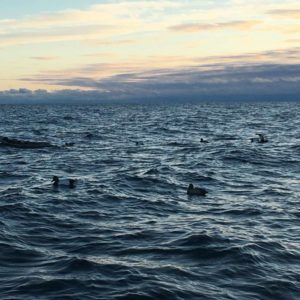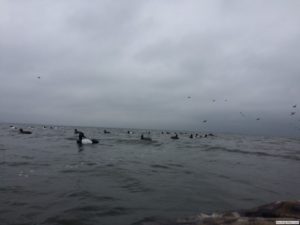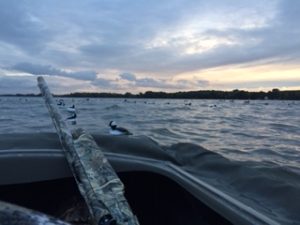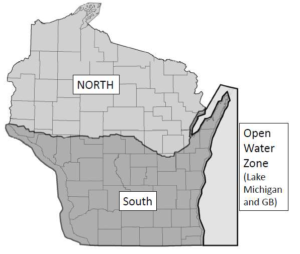 By Taylor Finger, WDNR Migratory Game Bird Ecologist
By Taylor Finger, WDNR Migratory Game Bird Ecologist
This article originally appeared in Wisconsin Waterfowl Association’s June, 2020 Open Water Edition Newsletter.
In 2021, Wisconsin will see its biggest waterfowling structure change in decades, with the creation of a Lake Michigan “Open Water Zone”. This will be the source of many debates around the duck camp. If you want to be knowledgeable for such debates, here’s the DNR background on how this zone came into existence.
FEDERAL EXPECTATIONS. Once every five years, states are allowed to review their zone structure and configuration and submit changes to the US Fish and Wildlife Service. Well, 2020 was the year that we needed to have Wisconsin’s decision on any changes regarding our zone configuration so that it would meet the federal timeline to be ready to go by the 2021 hunting season.
 As you can imagine, this is one of the most important regulatory decisions we make. It requires a lot of behind the scenes work and public outreach to ensure that what the DNR submits to the USFWS is what hunters want, as well as what provides the most opportunity for the state’s hunters. So, in late 2018 we created a committee with biologist and law enforcement representatives from the WDNR and reps from Wisconsin Waterfowl Association, Wisconsin Congress, Wisconsin Wildlife Federation, La Crosse County Conservation Alliance, Green Bay Duck Hunters, and several other waterfowl conservation organizations.
As you can imagine, this is one of the most important regulatory decisions we make. It requires a lot of behind the scenes work and public outreach to ensure that what the DNR submits to the USFWS is what hunters want, as well as what provides the most opportunity for the state’s hunters. So, in late 2018 we created a committee with biologist and law enforcement representatives from the WDNR and reps from Wisconsin Waterfowl Association, Wisconsin Congress, Wisconsin Wildlife Federation, La Crosse County Conservation Alliance, Green Bay Duck Hunters, and several other waterfowl conservation organizations.
This committee reviewed harvest data, previous waterfowl and hunter surveys, public input and anything else that could to help us make an informed decision. Our goal was to develop options to put into the department’s waterfowl hunter survey. This would be mailed to several thousand waterfowl hunters across the state. Additionally, WWA and Wisconsin Wildlife Federation used similar options from this committee in their own email survey to determine hunter preferences from the hunters they reach.
As per federal restrictions, states are constrained to selecting from the following zone and split configurations: four zones with no splits; three zones with one split; two zones with two splits; and one zone with two splits. After several meetings and group feedback, we were able narrow down our suite of options to:
- North, South and Mississippi River Zone (Hwy 10 or 64 North/South Boundary)
- North, South and Lake Michigan Zone (Hwy 10 or 64 North/South Boundary)
- North and South Zone (Hwy 10 or 64 North/South Boundary)
 We had extensive discussions regarding options like a North, Central, South Zone and the “U-zone” option, among others. In total, we considered ten different options. But, after review of the data and the feedback collected by the groups, these three options received the greatest consensus among the committee. So we put them in our waterfowl hunter survey that was sent out to hunters at the beginning of December 2019.
We had extensive discussions regarding options like a North, Central, South Zone and the “U-zone” option, among others. In total, we considered ten different options. But, after review of the data and the feedback collected by the groups, these three options received the greatest consensus among the committee. So we put them in our waterfowl hunter survey that was sent out to hunters at the beginning of December 2019.
Meanwhile, we were beginning our public input process to ask hunters their thoughts (which would supplement the survey) and reviewing all previous input regarding zone structure over the past four years. The consistent themes were:
- keep it the way it is,
- if the Mississippi river zone season is going to be so similar to the South zone, then give the third zone to someone else, and
- move the North/South boundary line further north.
I took these messages to all of my public meetings and hearings held throughout the winter of 2019 and spring of 2020 to gather as much public input and feedback as possible to make sure we made the right decision. So, here is the breakdown of all of the public input and survey information collected throughout this process.
Wisconsin Waterfowl Hunter Survey (WDNR) – This scientifically designed survey was mailed to nearly 3,000 randomly selected waterfowl hunters (1/3 North Zone, 1/3 South Zone, 1/3 Mississippi Zone) with approximately a 60% response rate. Both sample size and response rate are great enough to provide statistically accurate information.
When asked which zone option do you most prefer, the results came back:
- 42% – two zones – North and South
- 28% – three zones – North, South, Mississippi River
- 10% – three zones – North, South, Lake Michigan
These results were not necessarily surprising because we have to remember that 85% of the state hunts in either the North or South zone, so any options that include a different zone really mean very little to most of Wisconsin’s hunters. Additionally, we tend to see in mail-in surveys that status quo will usually outweigh any options that are different, and lastly, when this survey was sent out we didn’t include Green Bay in the Lake Michigan zone based on the committee feedback.
Wisconsin Waterfowl Association and Wisconsin Wildlife Federation Online Survey – WWA and WWF collaborated on their own survey that yielded over 700 responses. The results, shown in the Executive Director’s article in this newsletter, were important inputs to the process.
Wisconsin Department of Natural Resources Public Input (phone call, email, letter, online input tool) – Total of 2,185 comments (100 people in attendance at public hearings).
When asked what zone structure do you prefer for the 2021-2025 seasons the results were:
- 40% – three zone/one split (North, South, Lake Michigan/Green Bay; 825 comments)
- 33% – three zone/one split (North, South, Mississippi River; 685 comments)
- 27% – two zone/two splits (North and South; 551 comments)
- — – Other (two comments)
This reflects a significant shift towards support of an Open Water Zone on Green Bay and Lake Michigan.
We believe this is because for the three years stretching from 2017 to 2019, the Mississippi River Zone season structure only differed from the South Zone season structure by two days. Both the South Zone and Mississippi River Zone started on the same day (Saturday nearest Oct. 1) and the South zone took a five-day split whereas the Mississippi River took a seven-day split. This effectively exchanged a weekend in October for a Tuesday and Wednesday in December. While not everyone may have fully appreciated this trade-off, based on the public input and input from our conservation organizations, that was the season structure the majority preferred.
And as seen in 2020, our waterfowl hunter survey showed Mississippi River hunters preferred a five-day split, and nearly all of the conservation organizations voted to have the Mississippi River Zone season mirror exactly the same structure as the South Zone.
This begged the question: What’s the point of retaining a Mississippi River Zone if it looks exactly like the South Zone?
Two decades ago, the Mississippi River Zone was established with the prospect of 45- or 30-day waterfowl seasons. A separate zone would allow the dates to be adjusted to account for the migration timing along that flyway. But for twenty four years in a row we have been at a 60-day season and it doesn’t look like that is going to change in the near future, especially not in the next five years.
The USFWS guidelines that allow states to make zone structure changes also expects “the purpose of zoning is to provide a more equitable distribution of duck harvest opportunity among hunters throughout the state.” Since hunters in the Mississippi River Zone had shaped that zone to look much the same as the South Zone, the Mississippi River Zone did not meet that federal requirement to provide additional/unique opportunity.
 At the same time, hunters on the east side of the state argued that if the Mississippi River Zone is going to be effectively the same as the South Zone, then the two zones should be combined. This would create the opportunity to provide the Open Water/Layout hunters a unique Lake Michigan/Green Bay zone. Although the number of open waters hunters is smaller than found in the Mississippi river area, the hunting style, timing and species can be considerably different. Having a separate Open Water Zone would allow different season dates, thus providing additional hunting opportunity in the state. By the way, it is the fastest growing method of duck hunting in Wisconsin today.
At the same time, hunters on the east side of the state argued that if the Mississippi River Zone is going to be effectively the same as the South Zone, then the two zones should be combined. This would create the opportunity to provide the Open Water/Layout hunters a unique Lake Michigan/Green Bay zone. Although the number of open waters hunters is smaller than found in the Mississippi river area, the hunting style, timing and species can be considerably different. Having a separate Open Water Zone would allow different season dates, thus providing additional hunting opportunity in the state. By the way, it is the fastest growing method of duck hunting in Wisconsin today.
So we asked the public this spring for input on making this change, and the majority of public supported it, as did nearly all of the conservation organizations, and for that reason the DNR proposed eliminating the Mississippi River Zone, replacing it with an Open Water Zone (greater than 500 feet offshore on Green Bay and Lake Michigan).
We recognize that we can’t satisfy all 65,000 waterfowl hunters, but I hope you appreciate that we extensively surveyed and used all of the data available to make a decision that represents what the majority of waterfowl hunters would like to see, while adding as much opportunity as we can. Please recognize that this is a process that we take up every five years, and we have the opportunity to review these structures the next time this comes around. If you have any questions, please don’t hesitate to contact me, Taylor Finger at taylor.finger@wisconsin.gov or (608) 212-7923.

